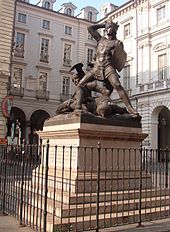Pelagio Palagi
Pelagio Palagi (* 1775 in Bologna , † 1860 in Turin ) was an Italian painter , sculptor and furniture designer .
Life
Filippo Pelagio Palagi received his education at the Accademia Clementina in Bologna . In 1806 he moved to Rome to the Accademia di San Luca , where he then became a teacher. Like his student Francesco Hayez , he was strongly influenced by Antonio Canova , the main exponent of Italian classicism . Palagi was interested in Egyptian, Greek, Etruscan and Roman sculptures, which he also collected. From 1815 to 1832 he lived and worked in Milan . In 1832 he moved to Turin at the invitation of Carlo Alberto from Sardinia-Piedmont . The Piazetta Reale in Turin, only separated from the Piazza Castello by a decorative grille designed by the artist, was designed by Palagi in 1835. Amedeo VI represents his monumental, classical monument in the Piazza Palazzo di Città . of Savoy (The Green Count), who was venerated in Turin as the hero of the Crusades. In 1836 Carlo Alberto appointed him “painter for the royal palaces” and commissioned him to furnish the Racconighi Castle and the Palazzo Real , for which he also designed furniture. At the same time he became director of the Scuola d'Ornato della Reale Accademia di Belle Arti .
A sculpture by the artist "Head with Short Curly Hair" was part of the art collection of Johann Wolfgang von Goethe . Palagi was highly valued by the French writer Stendhal (1883–1842) and was often mentioned in his main work The Charterhouse of Parma (La Chartreuse de Parme).
Individual evidence
- ↑ Pelagio Palagi, lounger with inlaid veneer (1832–35) ( Memento of the original from June 7, 2010 in the Internet Archive ) Info: The archive link was inserted automatically and has not yet been checked. Please check the original and archive link according to the instructions and then remove this notice.
- ↑ Birgit Pauls: Giuseppe Verdi and the Risorgimento: a political myth in the process of nation building , Akademie Verlag, 1996, p. 143
- ↑ Johann Wolfgang von Goethe, Christian Schuchardt , Walther Wolfgang Goethe, Wolfgang Maximilian Goethe: Goethe's Kunstsammlungen , F. Frommann, 1848, p. 134
- ↑ Stenhal, The Charterhouse of Parma (translated by Elisabeth Edl) , Hanser Verlag 2007, p 943, ISBN 978-3-446-20935-0
| personal data | |
|---|---|
| SURNAME | Palagi, Pelagio |
| BRIEF DESCRIPTION | Italian painter, sculptor and furniture designer |
| DATE OF BIRTH | 1775 |
| PLACE OF BIRTH | Bologna |
| DATE OF DEATH | 1860 |
| Place of death | Turin |
